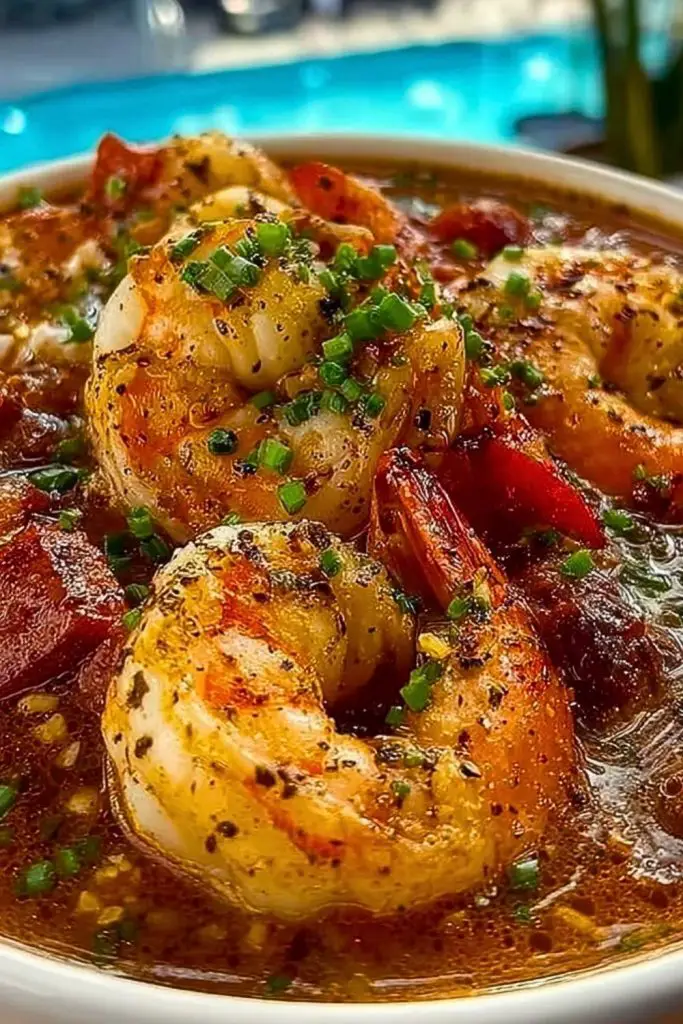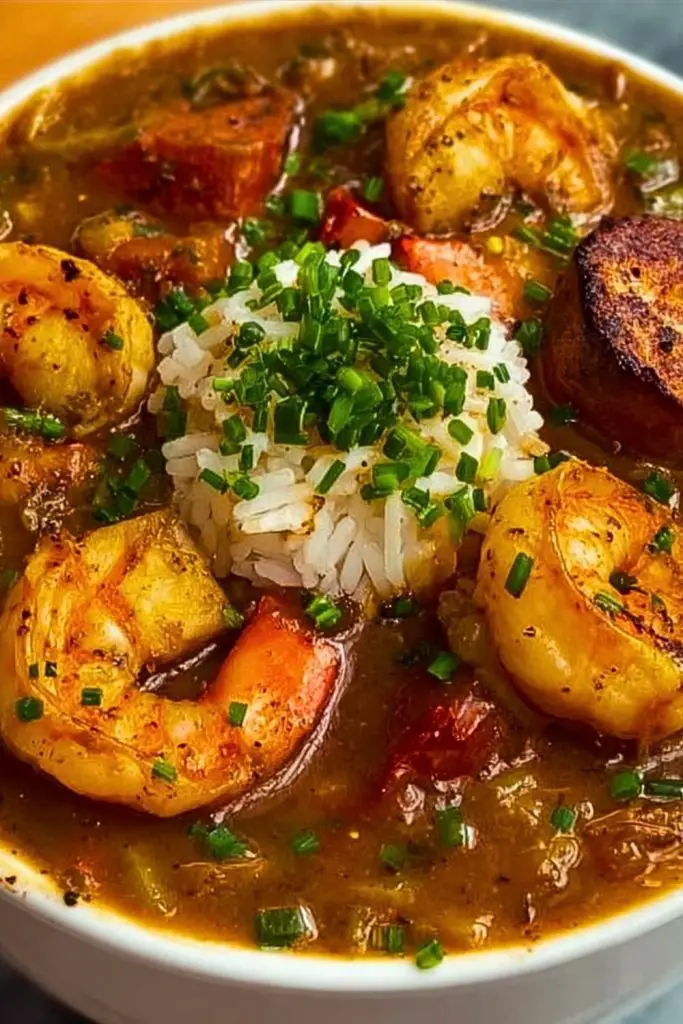When I crave something deeply comforting yet packed with flavor, I turn to this Ultimate Louisiana Seafood Gumbo. It’s the kind of dish that warms your soul, satisfies your appetite, and leaves everyone at the table asking for seconds. I’ve made this gumbo more times than I can count—sometimes for family gatherings, other times just to treat myself after a long week. Every spoonful is rich with layers of smoky roux, briny shrimp, spicy sausage, and tender crab, all brought together in that unmistakable Creole-style broth.

What makes this gumbo “ultimate” isn’t just the seafood (though there’s plenty of it); it’s how the flavors build slowly, patiently, until they explode in your mouth with every bite. I always start with a dark, nutty roux—stirred constantly until it hits that perfect deep brown—and I never rush it. That foundation is everything. Then I load in fresh seafood, sausage, the trinity of Cajun cooking, and spices that balance heat and earthiness. Trust me: if you’ve never made gumbo from scratch, this is the one to start with.
Why You’ll Love This Ultimate Louisiana Seafood Gumbo
If you’ve been searching for a hearty, soul-satisfying meal that’s bursting with Southern flavor, this gumbo is it. It’s rich and complex, yet balanced. The smoky roux and Cajun seasoning create an unbeatable base, while the combination of shrimp, crab, and sausage brings plenty of texture and protein. You’ll love how the ingredients all meld into a deeply flavorful stew. It’s a great make-ahead dish and gets even better the next day.
What Kind of Seafood Should I Use for Ultimate Louisiana Seafood Gumbo?
When it comes to seafood gumbo, freshness matters more than anything. I usually go for a mix of shrimp, crab, and sometimes crawfish if it’s in season. Gulf shrimp are my favorite—plump and sweet—and I prefer to leave the tails on for that traditional presentation. For crab, lump crabmeat adds tenderness, while claw meat brings in more briny depth. Some people love adding oysters, and I fully support that choice if you’re into a richer seafood flavor. The key is not to overcook the seafood, so it stays juicy and succulent in the gumbo.
You can even get creative and toss in mussels or scallops, but I recommend sticking to at least two types of seafood for a classic result. I always say: keep it rooted in Louisiana traditions, and your gumbo won’t steer you wrong.
Options for Substitutions
Not everyone has access to fresh Gulf seafood, and that’s totally okay. Here are a few solid substitutions that still keep the spirit of gumbo alive:
- Frozen Shrimp: Just make sure it’s raw and peeled. Avoid pre-cooked ones—they’ll turn rubbery.
- Imitation Crab Meat: If fresh crab isn’t available, this is an acceptable budget option.
- Chicken Thighs: For a meatier twist, tender chunks of chicken can be used in place of or alongside sausage.
- Andouille Sausage Alternatives: If you can’t find andouille, try smoked kielbasa or any spicy, smoked sausage.
- Gluten-Free Roux: Use a 1:1 gluten-free flour substitute with your oil to make the roux.
- Vegan Version: Swap seafood and sausage with mushrooms, jackfruit, or okra for a plant-based spin. Use vegetable broth instead of chicken or seafood stock.
Gumbo is one of those dishes that welcomes flexibility as long as the heart of it—the roux and the seasoning—stays intact.
Ingredients for This Ultimate Louisiana Seafood Gumbo
- All-Purpose Flour – The key to making the roux; it thickens the gumbo and gives it that deep, nutty flavor when browned properly.
- Vegetable Oil – Combined with the flour to create the roux. It needs to be neutral and able to withstand high heat.
- Yellow Onion – Part of the classic Cajun “holy trinity”; it builds the savory base.
- Celery – Adds aromatic depth and balances out the richness of the gumbo.
- Green Bell Pepper – The final piece of the trinity; brings a slight sweetness and texture.
- Garlic – Adds boldness and a punch of flavor that makes everything else pop.
- Andouille Sausage – Smoky and spicy, it brings a meaty contrast to the tender seafood.
- Shrimp (peeled and deveined) – Sweet and briny, they’re the star protein in the gumbo.
- Crab Meat (lump or claw) – Adds delicate, ocean-rich flavor and texture.
- Cajun Seasoning – A must-have blend of spices that defines the gumbo’s flavor profile.
- Bay Leaves – Infuse the gumbo with subtle herbal notes during simmering.
- Seafood or Chicken Stock – The liquid base that carries the flavor; homemade or store-bought works.
- Diced Tomatoes – Offer acidity and body, giving the gumbo more complexity.
- Green Onions – Used as garnish to add freshness and color before serving.
- Cooked White Rice – Traditionally served alongside or directly in the bowl with gumbo.
- Salt and Black Pepper – To fine-tune the flavor at the end.
Each ingredient plays a distinct role, from building a strong flavor foundation to creating a hearty, satisfying bite in every spoonful.

Step 1: Make the Roux
In a large heavy-bottomed pot or Dutch oven, combine the flour and vegetable oil over medium heat. Stir constantly for about 20 to 30 minutes, or until the roux turns a deep chocolate brown. Don’t walk away—it can burn quickly, and the flavor depends on getting this step just right.
Step 2: Sauté the Trinity
Once the roux reaches the perfect color, immediately stir in the chopped onion, celery, and green bell pepper. Cook for 5–7 minutes until the vegetables soften and release their aroma. Add the minced garlic and cook for another minute, stirring frequently.
Step 3: Brown the Sausage
Add the sliced andouille sausage to the pot and cook until lightly browned. This step helps release its oils and smoky flavor into the base.
Step 4: Pour in the Stock and Tomatoes
Gradually pour in the seafood or chicken stock while stirring to combine it with the roux and vegetables. Add the diced tomatoes and bay leaves, and bring everything to a gentle simmer.
Step 5: Add Seasonings and Simmer
Stir in the Cajun seasoning, salt, and black pepper to taste. Let the gumbo simmer uncovered for 45 minutes to an hour. This slow simmer helps the flavors develop and the gumbo to thicken.
Step 6: Add the Seafood
In the last 10–15 minutes of cooking, gently fold in the shrimp and crab meat. Stir occasionally until the shrimp are opaque and fully cooked through.
Step 7: Final Touches
Remove bay leaves, adjust seasoning if needed, and garnish with chopped green onions. Serve hot over freshly cooked white rice.
How Long to Cook the Ultimate Louisiana Seafood Gumbo
This gumbo isn’t a quick-cook dish—it’s all about slow, flavorful development. Here’s the time breakdown:
- Making the Roux: 20–30 minutes of continuous stirring
- Sautéing Vegetables & Sausage: Around 10 minutes
- Simmering the Gumbo: 45–60 minutes
- Cooking the Seafood: 10–15 minutes at the end
Altogether, expect the entire process to take about 1 hour and 45 minutes, depending on your pace. While it’s not a throw-together meal, the depth of flavor is absolutely worth every minute.
Tips for Perfect Gumbo
- Take Your Time with the Roux: Stir constantly and patiently. A dark roux is the foundation of great gumbo flavor.
- Prep Everything First: Chop veggies, slice sausage, and clean your shrimp beforehand to keep things flowing smoothly.
- Use a Heavy Pot: Cast iron or a thick-bottomed Dutch oven helps maintain even heat and prevents scorching.
- Don’t Overcook the Seafood: Add it near the end to keep shrimp tender and crab delicate.
- Let It Rest Before Serving: Gumbo always tastes better after sitting for a little while—it allows the flavors to meld.
- Skim the Fat: If you notice oil rising to the top after simmering, gently skim it off for a cleaner finish.
- Serve with Hot Rice: Traditional white rice soaks up the gumbo beautifully and completes the dish.
These small details make the difference between a good gumbo and an unforgettable one.
Watch Out for These Mistakes While Cooking
- Burning the Roux: This is the most common mistake. If it smells scorched, start over. A burnt roux will ruin the entire pot.
- Rushing the Process: Gumbo rewards patience. Don’t try to cook it on high heat to speed things up—you’ll lose depth and texture.
- Adding Seafood Too Early: Overcooked shrimp or crab turns rubbery and dry. Always add seafood toward the end.
- Skipping the Holy Trinity: Onion, celery, and bell pepper form the base flavor—leaving any one out will leave your gumbo feeling flat.
- Under-seasoning: Gumbo needs bold flavor. Taste and adjust as you go, especially after adding the stock.
- Using the Wrong Pot: Thin pots burn roux and scorch gumbo. Use a heavy-bottomed pan for even cooking.
- Forgetting the Bay Leaves: A small thing with a big impact—don’t skip them.
What to Serve With Ultimate Louisiana Seafood Gumbo?
Steamed White Rice
The classic pairing—light, fluffy rice balances the rich, bold gumbo.
Crusty French Bread
Perfect for dipping and sopping up that deeply seasoned broth.
Potato Salad
Yes, some Louisianans plop it right into the gumbo bowl! Creamy and cool, it’s an unexpected contrast.
Cornbread
A sweet-savory side that holds its own next to gumbo’s spice and depth.
Fried Okra
Crunchy and flavorful, it complements the stew beautifully without overshadowing it.
Collard Greens
Simmered greens offer a Southern veggie contrast and absorb the gumbo juices like a dream.
Simple Cucumber Salad
Cool, crisp, and refreshing—it helps cut through the richness of the gumbo.
Sweet Tea or Abita Beer
No Southern meal is complete without something cold to drink. Sweet tea or a local Louisiana beer hits the spot.
Storage Instructions
Gumbo stores incredibly well, and many people agree it tastes even better the next day. Once it cools to room temperature, transfer the gumbo into airtight containers:
- In the Fridge: Store for up to 4 days. Reheat gently over medium-low heat on the stovetop.
- In the Freezer: Gumbo freezes beautifully—just don’t freeze it with the rice. Store in freezer-safe containers for up to 3 months. Thaw overnight in the fridge before reheating.
Pro tip: If you’re making gumbo in advance, consider adding the seafood when you reheat it to keep the texture fresh.
Estimated Nutrition (Per Serving, without rice)
These values are approximate and based on a standard serving size of about 1.5 cups:
- Calories: 380
- Total Fat: 22g
- Saturated Fat: 6g
- Unsaturated Fat: 13g
- Trans Fat: 0g
- Cholesterol: 145mg
- Sodium: 910mg
- Carbohydrates: 18g
- Fiber: 3g
- Sugars: 5g
- Protein: 27g
Keep in mind that specific values will vary depending on the exact ingredients and serving sizes used. Adding rice or bread will increase calorie and carb totals.
Frequently Asked Questions
How dark should the roux be?
You want your roux to be the color of dark chocolate or an old copper penny. The darker it gets, the more intense and nutty the flavor—but watch it closely so it doesn’t burn.
Can I make this gumbo ahead of time?
Absolutely. Gumbo is one of those dishes that tastes even better the next day. Just store it in the fridge and reheat gently before serving.
Do I need filé powder for this recipe?
Not necessarily. Filé powder (ground sassafras leaves) is traditional and can be stirred in at the end as a thickener and flavor enhancer. It’s optional, though—it depends on your preference.
Is this gumbo spicy?
It has a gentle heat from the andouille sausage and Cajun seasoning, but you can easily adjust the spice level by adding hot sauce or extra cayenne to taste.
What’s the best sausage if I can’t find andouille?
Smoked kielbasa or any spicy, smoked sausage will work well. Just make sure it’s fully cooked and flavorful.
Can I use pre-cooked shrimp?
I don’t recommend it—pre-cooked shrimp can get tough and rubbery when simmered again. Use raw shrimp and add them at the end for best results.
Is it okay to skip the tomatoes?
Yes, some traditional gumbo recipes don’t include tomatoes at all. If you prefer a more classic, dark roux-only gumbo, you can leave them out.
Can I serve gumbo without rice?
Definitely. While rice is traditional, gumbo can also be served with cornbread or on its own as a hearty stew.
Conclusion
Making Ultimate Louisiana Seafood Gumbo is more than just following a recipe—it’s embracing a tradition. From stirring the roux to layering in spices and seafood, this dish brings comfort, culture, and richness to the table. Whether you’re cooking for a celebration or just craving something soulful, this gumbo never disappoints. Once you make it, you’ll understand why it’s a Southern classic that earns its place in every cook’s rotation.

Ultimate Louisiana Seafood Gumbo Recipe
- Total Time: 105 minutes
- Yield: 6 servings
Description
This deeply flavorful Louisiana Seafood Gumbo features a rich, dark roux, a medley of fresh shrimp and crab, spicy andouille sausage, and a classic mix of vegetables in a savory Creole-spiced broth. It’s hearty, comforting, and an unforgettable Southern classic perfect for feeding a crowd or enjoying leftovers all week.
Ingredients
0.75 cup all-purpose flour
0.75 cup vegetable oil
1 large yellow onion, diced
2 ribs celery, chopped
1 green bell pepper, chopped
4 cloves garlic, minced
12 ounces andouille sausage, sliced
1 pound raw shrimp, peeled and deveined
8 ounces lump crab meat
2 tablespoons Cajun seasoning
2 bay leaves
5 cups seafood or chicken stock
1 cup diced tomatoes
0.5 cup green onions, chopped (for garnish)
Cooked white rice, for serving
Salt and black pepper, to taste
Instructions
1. In a large pot or Dutch oven, combine flour and oil over medium heat. Stir constantly for 20–30 minutes until the roux is dark brown.
2. Add onion, celery, and bell pepper. Cook for 5–7 minutes until softened. Stir in garlic and cook for 1 more minute.
3. Stir in sliced sausage and cook until browned.
4. Gradually pour in stock, stirring to combine. Add diced tomatoes and bay leaves.
5. Stir in Cajun seasoning, salt, and pepper. Simmer uncovered for 45–60 minutes.
6. Add shrimp and crab in the last 10–15 minutes, cooking until shrimp are opaque.
7. Remove bay leaves, adjust seasoning, and garnish with green onions.
8. Serve hot over cooked white rice.
Notes
For extra flavor, toast your Cajun seasoning in a dry skillet before using.
Don’t add seafood too early—wait until the end to keep it tender and juicy.
Gumbo tastes even better the next day, so consider making it in advance.
- Prep Time: 30 minutes
- Cook Time: 75 minutes
- Category: Main Course
- Method: Stovetop
- Cuisine: Cajun, Creole
Nutrition
- Serving Size: 1.5 cups
- Calories: 380
- Sugar: 5g
- Sodium: 910mg
- Fat: 22g
- Saturated Fat: 6g
- Unsaturated Fat: 13g
- Trans Fat: 0g
- Carbohydrates: 18g
- Fiber: 3g
- Protein: 27g
- Cholesterol: 145mg
Keywords: seafood gumbo, Louisiana gumbo, shrimp gumbo

